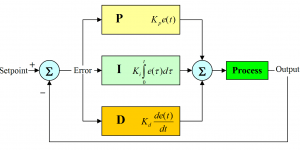In coffee maker industry the PID improves the brewing precision, by allowing the brewing temperature to be maintained between certain parameters.
What is a PID, and How Does It Work?
The PID of an espresso machine controls various heating elements of the unit. The PID controlled element can heat the brewing boiler, the milk steaming boiler, or with some high-end machines, the brew head. The PID increases the temperature in calculated increments in order to reach a set temperature as called Set Value (SV).
 A proportional-integral-derivative controller (PID controller) is a generic control loop feedback mechanism widely used in industrial control systems. A PID controller calculates an “error” value as the difference between a measured process variable and a desired setpoint. The controller attempts to minimize the error by adjusting the process control inputs.
A proportional-integral-derivative controller (PID controller) is a generic control loop feedback mechanism widely used in industrial control systems. A PID controller calculates an “error” value as the difference between a measured process variable and a desired setpoint. The controller attempts to minimize the error by adjusting the process control inputs.
How Does a PID Help Us Pull Better Espresso Shots?
If the boiler of the espresso machine gets overheated, the espresso shot will over-extract and it will be bitter. An espresso machine equipped with a PID ensures the perfect extraction temperature for your shot.
Another reason is a better control over the brewing temperature, depending on the grind size and the roast. For instance, with light roasted beans we need to slightly increase the extraction temperature. Without a PID, the brewing temperature is the calibrated one on the thermostat, or “pressurestat”. That is one temperature for all roasts and grind sizes. With a PID you can set your brewing temperature as desired.
Depending on the beans’ origin we might need to modify both the extraction temperature and the grind size.